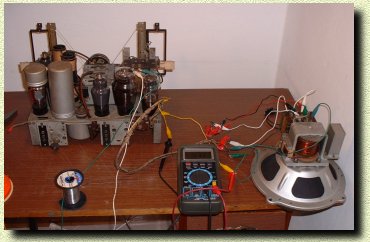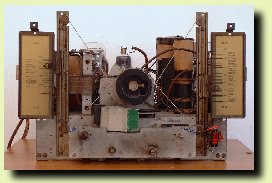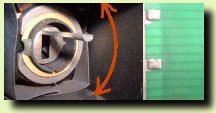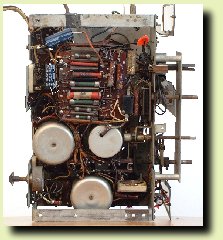 |
Pictures taken before my restoration,
you can see tons of dust above the tubes and the chassis. This tube
is the U12 rectifier, a double diode with direct heathing. The heathers
of this receiver are supplied with a 4.5V alternate voltage. |
The wood cabinet, before the
restoration. Two days of job in order to restore it to the original
state. |
|
 |
Picture
taken during the firts "warm up & test" of the receiver. In
this old radios is important to supply the main power with a variac,
in order to increase the voltage applied in little steps. Otherwise
capacitors blast or tubes heather broken could result. |
This is a detailed view of the tuning indicator. It's a coil inserted
between the anodic supply and the MF tubes with a shutter and a
little lamp. When the receiver is tuned on a station the anodic
current of the MF tube increases and this move the shutter down.
The lamp behind the shutter create a shadow on the green scale,
this to display the exact tuning of the receiver. |
|
 |
Detailed view of the big loudspeaker.
In this old radios the magnetic field in order to operate the speaker
is generated by a coil (the red one) This coil is powered by the
anodic supply. |
Rear view of the chassis. You
can see the BIG triode PX4 (the audio power tube) and on the right
corner a variable resistor. This resistor balances the heather voltage
against the ground, this to reduce the hum. Infact in this receiver
the tubes are without catode, they works with a direct heathing.
|
|
 |
Front view of the receiver.
You can see the tuning scales (OM and OL) and the central pulley
connected to the variable capacitor. In this receiver the power
on swicth is the band selector. There is a position where the receiver
powers off. |
Behind view of the chassis.
All the resistors and capacitors are mounted near on a "capacitor
box". On the left you can see the two new electrolitic capacitors.
The big circles with a screw in the middle are the MF transformers,
many different from the newest one. |
|










